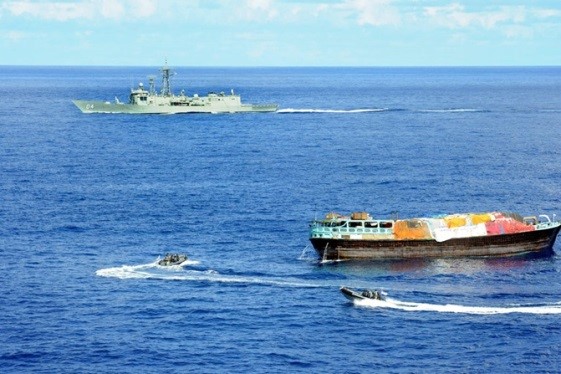 Is there an increasing cooperation in the Indian Ocean to curb drug smuggling today? After piracy and terrorism, are the drug smugglers and their network being targeted now in the Indian Ocean? What is the nature of counter actions so far, and what needs to be done further?
Is there an increasing cooperation in the Indian Ocean to curb drug smuggling today? After piracy and terrorism, are the drug smugglers and their network being targeted now in the Indian Ocean? What is the nature of counter actions so far, and what needs to be done further?
The Kenyan Operations, August 2014
Last month, President Uhuru Kenyatta flew in a Kenyan Air Force helicopter escorted by two Russian made MI 17 helicopters to personally oversee the destruction of the ship MV Bushehr Amin Darya alias Al Noor with its cargo of about 370 Kilograms of heroin worth US $ 11.4 million in international market. The vessel was escorted out of the harbour by three Kenyan naval ships and sunk 18 nautical miles from the coast by using explosives. Significantly, the President acted despite the Kenyan High Court ruling that the destruction of the vessel should be delayed till the trial of the accused (9 foreigners and 3 Kenyans) is completed. Also, the court admitted the defense counsel’s plea that the sinking of the vessel had safety and environmental risks.
President Kenyatta’s initiative should be seen as a strong message to the drug mafia, smuggling ships and agents both in Kenya and overseas about his country’s commitment to prevent labeling Kenya as a transshipment hub of illicit global trade in narcotics. In recent times, the United Nations Office on Drugs and Crime (UNODC) cited ‘Kenya as a transit point for re-packaging and trans-shipment of drugs to Europe and America’. Perhaps what is more disturbing is that east coast of Africa is also popular among drug smugglers from Colombia.
Countering the Drug Network: Actions in 2014
In the first half of 2014, a number of boats / dhows carrying drugs have been intercepted by the ships of Combined Task Force (CTF) 150 operating under the Combined Maritime Forces (CMF). In January 2014, HMCS Toronto, a Canadian warship intercepted a vessel carrying 280 kilograms of heroin packed in 265 bags about 40 nautical miles off the coast of Tanzania. A few months later, a British Royal navy ship HMS Somerset intercepted a fishing boat carrying 60 kilograms of drugs. This was followed by Australian Navy’s HMAS Darwin intercepting a dhow carrying 1032 kilograms of heroin in 46 sacks concealed in the consignment of bags of cement. Apparently, the drugs were to be transferred on the high seas to three dhows, bound for Zanzibar and Malindi which is known to be a haven for drug smugglers and money launderers.
It has been the policy of the Combined Maritime Forces to destroy the contraband at sea and allow the crew and the dhows to continue on their voyage. Apparently, this is due to operational constraints since escorting the captured vessel back to home countries would entail long legal processes. Further, this approach could be attributed to the absence of onboard ‘mechanism to enable drug trafficking prosecutions.’ The UNODC is of the view that the drug smugglers should be prosecuted and not allowed to escape with impunity.
The above intercepts off the east coast of Africa suggest that the drug consignments may have originated in South Asia (Afghanistan / Pakistan / India), Southeast Asia (Thailand / Myanmar) and Latin America (Colombia). Further, East African coast (Djibouti, Eritrea, Kenya, Somalia and Tanzania) has emerged as the transshipment hub and some reports suggest that on an average, nearly 24 tons of drugs valued at US $ 190 million are smuggled annually from the region. The easy availability of drug in East Africa appears to have encouraged Al Shabaab which is most active in Somalia, to have links with drug cartels and the drug business helps the organization to acquire weapons and other logistics.
What Next?
After the attacks on USS Cole, MV Limburg and the 2008 Mumbai terror attacks, maritime security analysts were able to impress upon policy makers that robust maritime capabilities were critical to address terrorism in the littorals and at sea. Likewise, over the past five years, the Combined Maritime Forces have successfully controlled the Somali piracy and according only ten incidents of attack on shipping have been reported in waters around Gulf of Aden-Red Sea- Somalia coast which is a welcome sign.
Apparently the strategic community has got ‘locked’ into counter terrorism and anti piracy. The drug hauls illustrated above clearly showcases that maritime security has several dimensions and the policy-makers would have to understand the complex nature of security in the maritime domain. Although the threat of maritime terrorism may have reduced and piracy off Somalia contained, the Indian Ocean littorals would need to develop capacities to address new forms of threats and challenges. In that context, EUNAVFOR and NATO decision to extend operations until the end of 2016 in the Indian Ocean is a welcome development.
By Special Arrangement with Institute of Peace and Conflict Studies (http://www.ipcs.org)